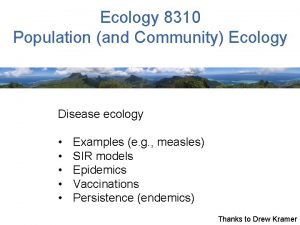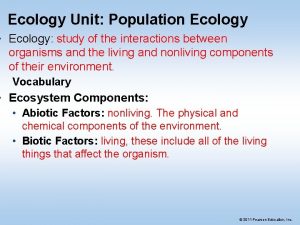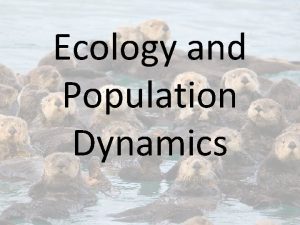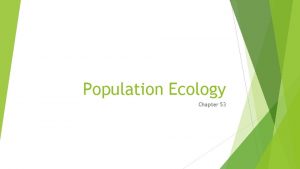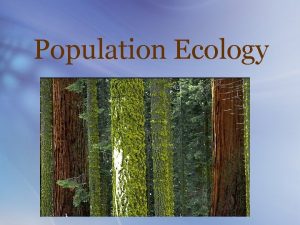POPULATION ECOLOGY 1 Population Population is the group











- Slides: 11

POPULATION ECOLOGY 1. Population: Population is the group of organisms of same specie living in same place at same time and can interbreed among them. e. g. population of kinnow in Sargodha fields. 2. Population Ecology: The ecological study of how Biotic and Abiotic factors affect the size, distribution and density of a population. The organism of a population must rely upon same resources, have good chance of interbreeding with each other and have similar environmental factors. 3. Features of Population Ecology: 3. 1. Population Size: Population size is the estimated current total population of the species within the area of interest (globe, nation, or sub nation), based on naturally occurring and wild individuals of reproductive age or stage (at an appropriate time of the year), including mature but currently non-reproducing individuals. Factors that affect population size are: � Birth and Immigration increases population size � Death and Emigration decreases population size Pop. Change = (birth + immigration) - (death + emigration) [ ሿ� [ ሿ۳

BCHF 18 M 032 POPULATION ECOLOGY For example in a population of rabbit if three rabbits are born and one died while one rabbit immigrate from other population and two rabbits emigrate then population will be given as: [� ሿ� [ ሿ So, intrinsic growth rate “r” will be 0. 1. 3. 2. Population Density: Population density is a measurement of population per unit area, or exceptionally unit volume, it is a quantity of type number density. It is frequently applied to living organisms, most of the time to humans. It is a key geographical term. In simple terms, population density refers to the number of people living in an area per square kilometer. Population Density are of two types: � Crude Density It’s the density per unit total space � Specific Density It’s the density per unit total habitat space i. e. available area that can actually colonized by the population Population Density of PAKISTAN is 287 per k or 742 people per m. Variations in population density of Pakistan

BCHF 18 M 032 POPULATION ECOLOGY 3. 3. Population Distribution: Dispersion or distribution patterns show the spatial relationship between members of a population within a habitat. Individuals of a population can be distributed in one of three basic patterns: uniform, random, or clumped. 3. 3. 1. Uniform Distribution: Uniform distribution refers to organisms that live in a specific territory. One example would be penguins. Penguins live in territories, and within those territories the bird’s space themselves out relatively uniformly. 3. 3. 2. Random Distribution:

BCHF 18 M 032 POPULATION ECOLOGY Random distribution refers to the spread of individuals such as wind-dispersed seeds, which fall randomly after traveling. 3. 3. 3. Clumped Distribution: Clumped dispersion refers to a straight drop of seeds to the ground, rather than being carried, or to groups of animals living together, such as herds or schools. Schools of fish exhibit this manner of dispersion. ‘’Mostly population lived in clumped or clustered population’’ Comparison of Different Types of Population Dispersion:

BCHF 18 M 032 POPULATION ECOLOGY 3. 4. Sex Ratio: The sex ratio is the ratio of males to females in a population. In most sexually reproducing species, the ratio tends to be. This tendency is explained by Fishers Principle, as of 2014, the global sex ratio at birth is estimated at 107 boys to 100 girls (1000 boys per 934 girls). 3. 5. Age Structure: The age structure of the population is an important factor in the strength of the population. Age structure forms part of the population at various ages. Models that include age structure allow for better predictions of population growth, as well as the ability to correlate this growth with the rate of economic development in the region. The fastest-growing countries have the pyramid shape in their age-old sketch drawings, reflecting the earlier similarities of young people, many of whom are of reproductive age. This pattern is often observed in developed countries where people are less likely to live due to poor living conditions, and there is a higher birth rate. Age structures of areas with slow growth, including developed countries such as the United States, still have a pyramidal structure, but with many fewer young and reproductive-aged individuals and a greater proportion of older individuals. Other developed countries, such as Italy, have zero population growth. The age structure of these populations is more conical, with an even greater percentage of middleaged and older individuals. The actual growth rates in different countries are shown in figure with the highest rates tending to be in the less economically developed countries of Africa and Asia.

BCHF 18 M 032 POPULATION ECOLOGY 4. Population Growth: It shows a change in the population over a period of time. Population growth rates are affected by birth and death rates, which are also related to local resources or external factors such as weather and disasters. Reduced services will result in an increase in population. Reasonable growth means population growth when resources are limited. 4. 1. Exponential Growth: When a population experiences unlimited resources, it tends to grow very fast. This is called exponential growth. The virus, for example, will increase significantly when given access to unlimited nutrients. However, that growth will not continue forever. 4. 2. Carrying Capacity: Carrying capacity: Because the real world does not provide unlimited resources, a growing population will eventually reach the point when resources become scarce. Then the rate of growth will go down and up. When the population reaches this filtering point, it is considered the largest number of organisms that can cure it. The name of this situation is powerful. The letter K represents the burden. 4. 3. Birth And Death Rates: Prevalence, number of births and deaths: With the increase in population, researchers have long used demographics to study population changes over time. Such changes occur with birth rates and mortality rates. or example, population growth can lead to higher fertility rates due to more potential partners. However, and this can lead to high death rates from competition and other variants such as the disease. People remain stable when birth and death rates are equal. When birth rates are higher than death rates, the population increases. When death rates drop by birth rates, the population drops. This example, however, does not take into account human migration and migration. Life expectancy also plays a role in

BCHF 18 M 032 POPULATION ECOLOGY human learning. When people live longer, they also affect resources, health, and other things. 4. 4. Limiting factors: Economists are studying the factors that hinder population growth. This helps them to understand the change that is taking place. It also helps them to predict the future. Resources in the surrounding area are examples of limited resources. For example, plants need a certain amount of water, nutrients and sunlight. Animals need food, water, shelter, access to mates and safe places to find nests. 4. 5. Demographic control: When the population of the population discusses population growth, it is because of the number of people that are dependent or independent of the population. Population-based regulation of iron defines a condition in which population size affects their growth and death. Regulation based on complexity is often more biotic. 4. 6. Density-dependent population regulation: When population ecologists discuss the growth of a population, it is through the lens of factors that are density-dependent or density-independent. Densitydependent population regulation describes a scenario in which a population’s density affects its growth rate and mortality. Density-dependent regulation tends to be more biotic. For example, competition within and between species for resources, diseases, predation and waste buildup all represent density-dependent factors. The density of available prey would also affect the population of predators, causing them to move or potentially starve. 4. 7. Density-independent population regulation: In contrast, density-independent population regulation refers to natural (physical or chemical) factors that affect mortality rates. In other words, mortality is influenced without density being taken into account. These factors tend to be catastrophic, such as natural disasters (e. g. , wildfires and earthquakes). Pollution, however, is a manmade density-independent factor that affects many species. Climate crisis is another example.

BCHF 18 M 032 POPULATION ECOLOGY 4. 8. Exponential and Logistic Growth Rate: Exponential population growth: When resources are unlimited, populations exhibit exponential growth, resulting in a J-shaped curve. When resources are limited, populations exhibit logistic growth. In logistic growth, population expansion decreases as resources become scarce. The best example of exponential growth is seen in bacteria. Bacteria are prokaryotes that reproduce by prokaryotic fission. This division takes about an hour for many bacterial species. If 1000 bacteria are placed in a large flask with an unlimited supply of nutrients (so the nutrients will not become depleted), after an hour there will be one round of division (with each organism dividing once), resulting in 2000 organisms. In another hour, each of the 2000 organisms will double, producing 4000; after the third hour, there should be 8000 bacteria in the flask; and so on. The important concept of exponential growth is that the population growth rate, the number of organisms added in each reproductive generation, is accelerating; that is, it is increasing at a greater and greater rate. After 1 day and 24 of these cycles, the population would have increased from 1000 to more than 16 billion. When the population size, N, is plotted over time, a Jshaped growth curve is produced. 5. Importance of Population Ecology: Population ecology is important in conservation biology, especially in the development of population viability analysis (PVA) which makes it possible to predict the long-term probability of a species persisting in a given habitat patch. 6. Seed Bank:

BCHF 18 M 032 POPULATION ECOLOGY A seed bank is the reservoir of viable seeds present in a plant community. Seed banks are evaluated by a variety of methods. For some species, it is possible to make careful, direct counts of viable seeds. In most cases, however, the surface substrate of the ecosystem must be collected and seeds encouraged to germinate by exposure to light, moisture, and warmth. The germinating seedlings are then counted and, where possible, identified to species. 6. 1. Condition for Storage and Regeneration: Seeds are living organisms and keeping them active for long periods of time requires correcting the humidity and temperature. When they grow in the mother plant, most seeds get the inside energy to survive the drought. The survival of these so-called 'orbs' can be increased by dry and low temperature storage. The level of dryness and cold depend a great deal on the long-term survival and investment in affordable infrastructure. Active guidelines from US scientist in the 1950 s and 1960 s, James Harrington, are known as' Thumb Rules. 'Hundreds Rule' guidelines that the total humidity and temperature (at Fahrenheit) should be less than 100 for the sample to survive for 5 years. Another rule is that reducing water content by 1% or temperature by 10 degrees Fahrenheit will double the life span of the seed. Studies conducted in the 1990 s have shown that there are limits to the beneficial effects of drying or cooling, and should therefore not be overstated. To understand the effect of water content and temperature on long-term seed engagement, the United Nations Food and Agriculture Division and a consulting group called Bioversity International developed a set of standards for overseas seed banks to maintain longevity. This document promises to dry the seed at about 20% humidity, seal the seed in high humidity containers, and keep the seed at 20 degrees Celsius. These cases are often referred to as the final 'normal' agreements. Seeds from our most important varieties corn, wheat, rice, soybeans, peas, tomatoes, broccoli, watermelon, sunflower, etc. It can be stored this way. However, there are many varieties that produce seeds that are relatively resistant to dryness or low temperatures in standard storage containers. This species should be maintained cryogenically. Orange orchard, coffee, avocado, coconut, papaya, oak, walnut and willow are just a few examples of species to be kept cryogenically. As always, the seeds eventually shrink. It is difficult to predict when a seed loses and so many seed banks control the germination capacity during storage. When the

BCHF 18 M 032 POPULATION ECOLOGY percentage of seed sowing decreases below the set value, the seed needs to be replaced and the new seed collected in another long cycle. 6. 2. Soil Seed Bank: Soil seed bank, natural storage of seeds in the leaf litter, on the soil surface, or in the soil of many ecosystems, which serves as a repository for the production of subsequent generations of plants to enable their survival. The term soil seed bank can be used to describe the storage of seeds from a single species or from all the species in a particular area. Given the variety of stresses that ecosystems experience—such as cold, wildfire, drought, and disturbance—seed banks are often a crucial survival mechanism for many plants and maintain the long-term stability of ecosystems. Soil Seed dormancy and environmental constraints on germination influence various characteristics of soil seed banks. For example, seed dormancy determines how long a seed can remain viable in the soil. Factors such as embryo immaturity, chemical inhibitors, and physical constraints influence seed dormancy. Light filtered through plant canopies, for example, can inhibit germination in some species, while a long winter chilling may break dormancy in other species. The result is a considerable variety in the patterns of germination of the seed banks by seasons, disturbances, or other environmental shifts.

BCHF 18 M 032 POPULATION ECOLOGY 6. 3. Ariel Seed Bank: A canopy seed bank or aerial seed bank is the aggregate of viable seed stored by a plant in its canopy. Canopy seed banks occur in plants that postpone seed release for some reason. It is often associated with serotiny, the tendency of some plants to store seed in a cone (e. g. in the genus Pinus) or woody fruits (e. g. in the genus Banksia), until seed release is triggered by the passage of a wildfire. It also occurs in plants that colonise areas of shifting sands such as sand dunes. In such cases, the seed is held in the canopy even if the canopy becomes buried; thus the seed is anchored in place until good germination conditions occur. 6. 4. Advantages of Storing Seed: We can buy seeds from agricultural shops and orchards, but these are definitely not the best plants for your plants. By keeping the seeds from one season to another, the seeds have time to adapt to your weather and will produce vegetables or fruits that are more prone to disease The benefits of seed preservation are not only a better product, but it will also save you money as you do not have to buy new seeds every year to start your season. By keeping seed and using it year after year, we also help keep the pressure at risk growing as many are blocked by seed suppliers for modified varieties to save money. Seed conservation is financially viable for us and provides a better product, while helping to diversify the eco-diversity system, by providing you with seeds that are more adaptable to your climate and environment.
 Chapter 4 population ecology answer key
Chapter 4 population ecology answer key Section 1 population dynamics answer key
Section 1 population dynamics answer key Population ecology section 1 population dynamics
Population ecology section 1 population dynamics Population ecology section 1 population dynamics answer key
Population ecology section 1 population dynamics answer key Clumped dispersion
Clumped dispersion Define exponential population growth
Define exponential population growth Is india near the equator
Is india near the equator Population vs community ecology
Population vs community ecology Concept 3 population ecology
Concept 3 population ecology Chapter 53 population ecology
Chapter 53 population ecology Chapter 36 population ecology
Chapter 36 population ecology Chapter 4 population ecology answer key
Chapter 4 population ecology answer key
















